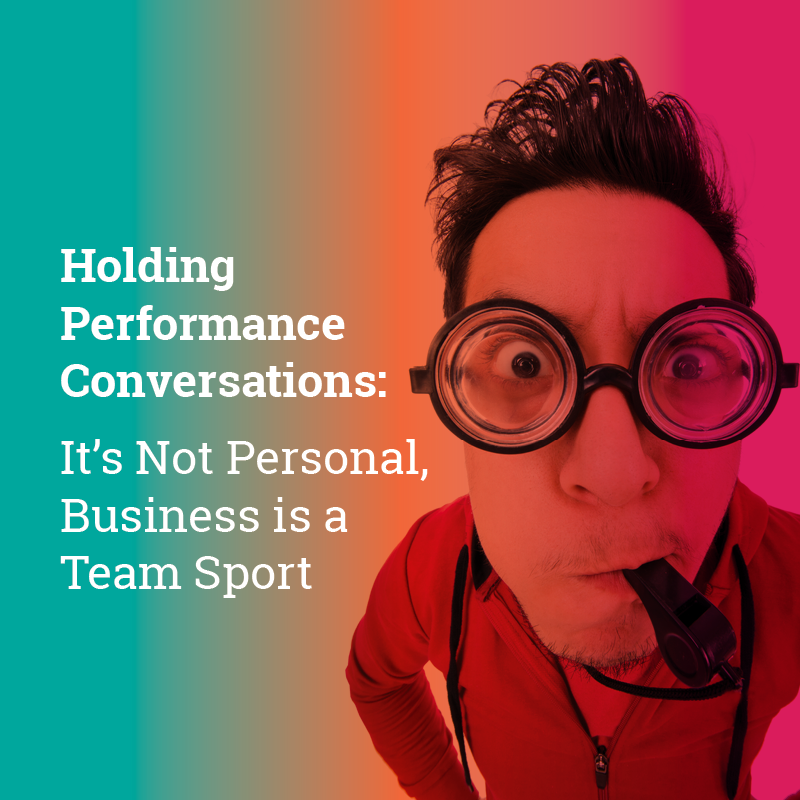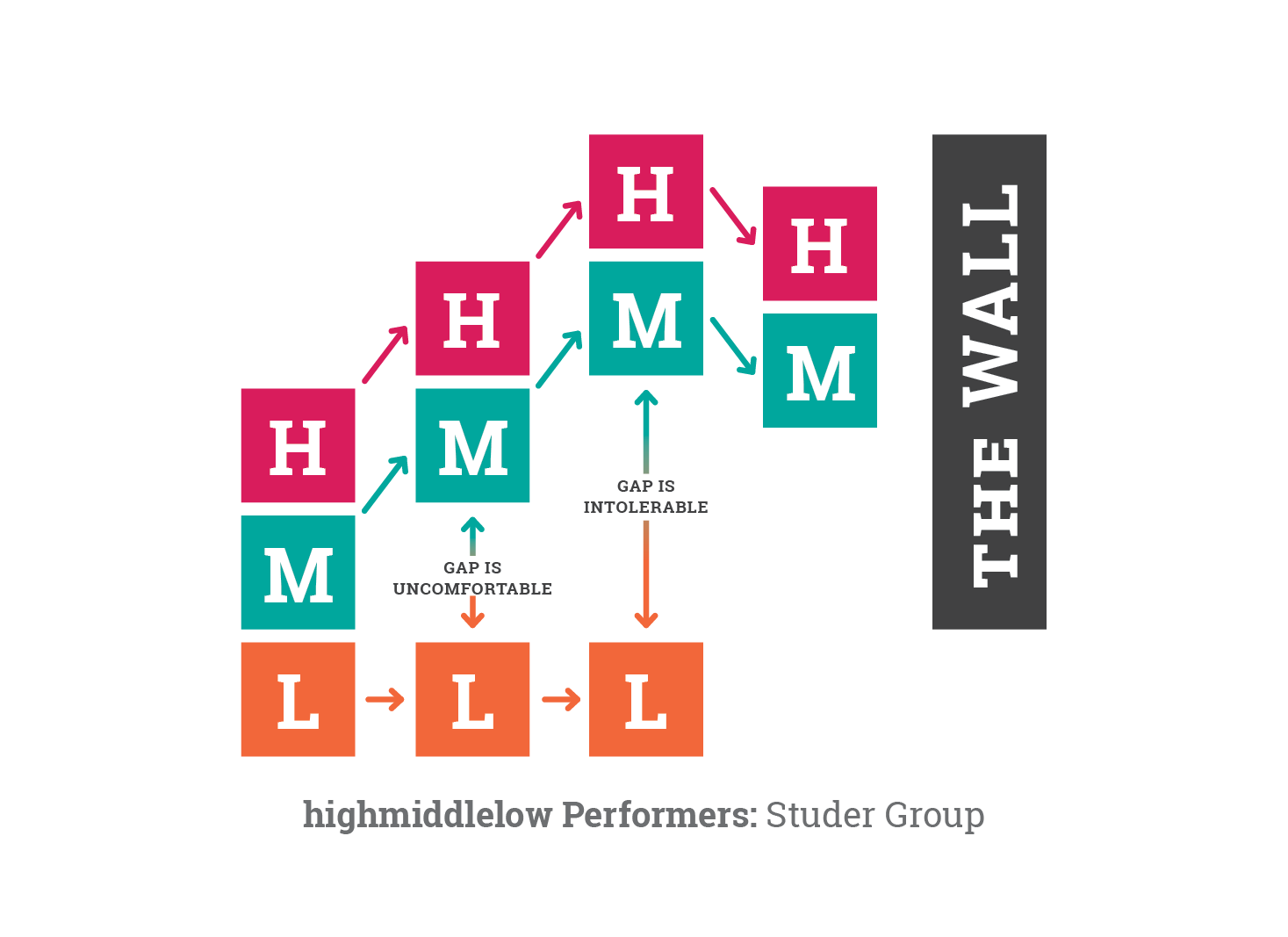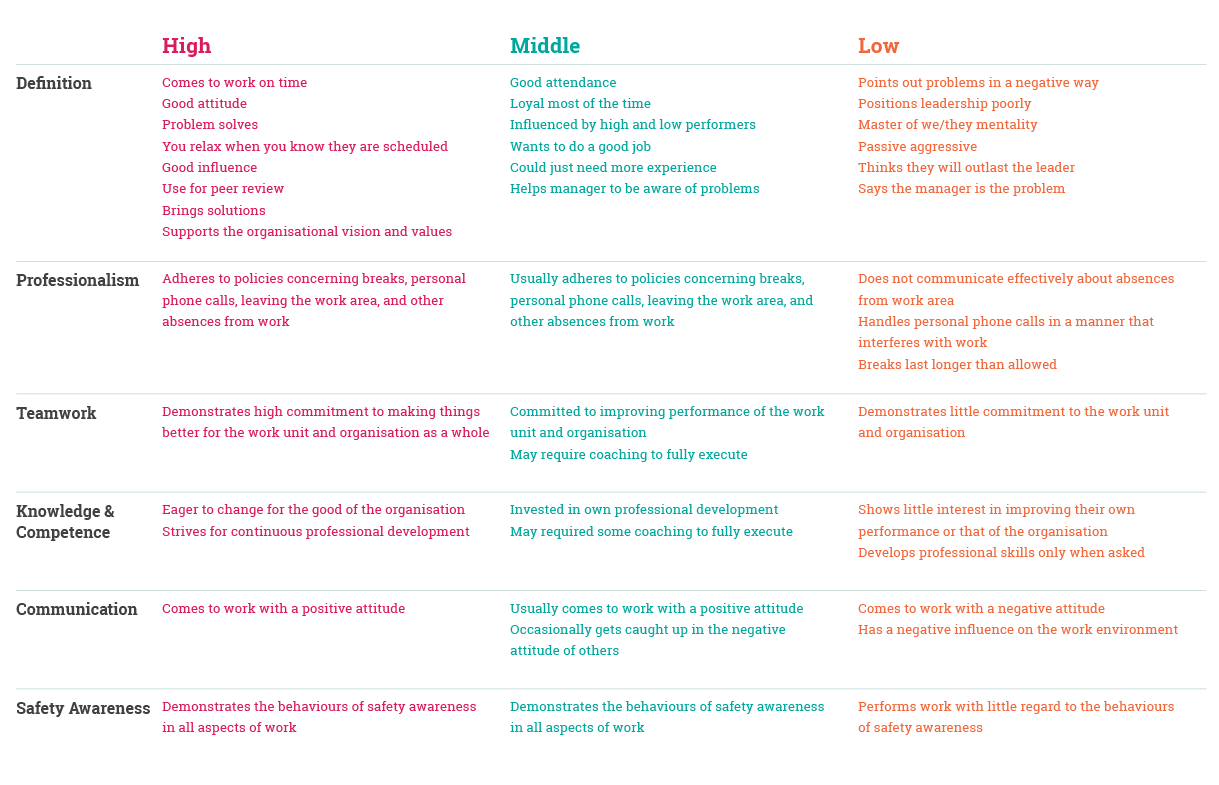Holding Performance Conversations:
It’s Not Personal, Business is a Team Sport
I recently facilitated a performance conversation workshop ‘highmiddlelow’ designed by Quint Studer, founder of the health care consulting company, Studer Group. His performance conversation methodology changed what I previously believed about holding performance management conversations. Quint suggests that if you need to enable improved operational performance you need to engage in performance management conversations with your entire team. The twist in his concept is to start your conversations with your high performers first, moving them forward and enabling higher performance within the team. Moving high performers first opens up a gap that the middle performers can move into if you next initiate performance conversations with this group. Quint’s model advocates that low performer conversations should be initiated last. His concept suggests that the gap in demonstrated behaviours between low and middle performers becomes obvious and uncomfortable causing the low performer to consider moving their performance up [to standard] or off the team [as the temperature and pressure on them increases].
High Middle Low performance characteristics
In understanding and applying Quints model it is necessary to understand the specific characteristics of each of the high middle low performance groups. The table outlined below was developed based on the findings from Studer Group’s national learning lab.
Once you have determined the characteristic of your employee and which group they fit in to, you are ready to start holding performance conversations. Let’s look at how to enable performance conversations with each of the groups.
High performer conversations
When holding a performance conversation with a high performer, start your conversation by sharing with them the direction that the organisation is going in. High performers need to know that they are working for a successful organisation that is heading in the right direction. Thank them for their work and contribution that they make to the organisation and team. Outline how and why they are so important. Then ask if there is anything that you can do for them to make their job even more satisfying for them.
- Tell them where the organisation is going; share the direction and success
- Thank them for their work and contribution
- Outline how and why they are so important to the team and organisation
- Ask if there is anything you can do for them
High performer conversation in action!
Thank you for meeting with me Julie, I am excited to have this conversation with you to share with you where our team and organisation is heading and to let you know what a positive impact your performance has had on us all. As you are aware your team has been working towards 10% growth on last year’s sale figures and are aiming to be the top performing sales team within the business.
Julie you play a large role in getting this goal accomplished. When you go in a room to hold a conversation with your team it’s upbeat and positive. You always look to proactively problem solve any challenges that arise. You always go above and beyond and this impact can be seen in our satisfaction and sales performance rates. The morale of your team is so high.
The other thing you do really well is growing and developing others. You always talk about our goals and our values. You hold tactful and respectful conversations with people to help them analyse and reflect. You always engage in conversations to help people consider how they went in situations they encountered. Last week I heard you reflecting with Rosie on a difficult client call that she took. You were empathetic and genuine in your response sharing with her a client story on a similar situation you had had. I watched how allowing her to learn from her mistakes rather than making her feel like a failure, sent her back to her desk with a positive mind set.
What I value the most is your attitude. We have had some difficult targets to achieve with limited resources and you always approach each day with a positive attitude. It’s a credit to you and it clearly rubs off on your team.
You are an excellent employee and I hope you are going to be a long term employee with us. Is there anything right here and now, any concerns that you think we need to address? Is there anything specifically you need my help with? In order to grow and develop you further is there anything you have been considering that we could action plan together. [Discuss and explore developing SMART development goals together].
Thanks Julie for your time today. The way you handle your team; let people know you are available and your positive can do attitude is what sets you apart from others. You are valued and sincerely appreciated.
Middle performer conversations
When holding a performance conversation with a middle performer start by reassuring them that their job is secure and that you want to see them grow and develop within the team. Relax them; let them know that you are meeting with everyone with the view to enabling personal development plans and that their job is not in question. Thank them for what they do, sharing with them their good qualities. Discuss with them coaching and development opportunities that would see them grow further. Finish your conversation on a positive note thanking them once more for their contributions to the team and reaffirm their good qualities.
- Reassure them that your goal is to retain them
- Support them: Thank them for what they do; share with them their good qualities
- Coach them in their professional development opportunities; and/or ask them if there is anything they would like to develop
- Thank them again and reaffirm their good qualities
Middle performer conversation in action!
Take a seat, Bruce. Thank you very much, I appreciate you making the time to get together. You know I am meeting with everyone and I want to start by saying that I absolutely see you as long-term employee.
Your customer service skills are great, you interact with staff well, you always help the food division with whatever they need. We like to see staff develop and I’d like to do a little coaching with you now. There is one item I would like to discuss with you. Do you know what I perceive your development opportunity to be? [Probe and encourage self-reflective discussion].
I want you to focus on your wastage control. Your reports suggest that there is an issue in your department. Steve’s department is getting great results by measuring and recording wastage at the end of each shift. Why don’t you spend some time with him to observe his process and see if you think that would work in your area? Try what he does for one week and we’ll observe the results? If we fix up your wastage percentage your bottom line contribution made by your team will be lifted 3% taking you from 7th to 5th on the team ladder board.
You are an important asset to the organisation Bruce, your customer service results are amongst the highest. It will be great to help you sort out your wastage issues and see you achieve better results in that area. Do you have any questions for me or are you happy to touch base with me again in a week to review progress?
Low performer conversations
When holding a performance conversation with a low performer, never start the meeting off on a positive note and mix your message. Let them know that you are going to do the talking and that they are going to do the listening. Advise them that they need to let you finish and that once you have finished you will listen to their reply. If you think that the discussion is going to be difficult have someone with you and afford them the same opportunity. Start by describing the behaviour you have observed which is not appropriate; be specific and provide them with examples. Next, share with them how you feel. Show them what needs to be done; demonstrate what a good job looks like and the standard you expect from them moving forward. End the conversation by clearly outlining the consequences that will occur if the current performance standard continues; continuance of the behaviour will afford them a written warning.
- Do not start the conversation on a positive note
- D: Describe what has been observed
- E: Evaluate how you feel
- S: Show what needs to be done
- K: Know consequences of continued performance
Low performer conversation in action!
Preamble to this conversation: A low performer is not a middle performer simply having a bad day. A low performer usually demonstrates unprofessional and an inappropriate attitude on an ongoing basis. In establishing the context for the conversation below, informal discussions have been held with the low performer outlining concerns with their behaviour and attitude. They have been offered suitable professional development, support, resources, counselling and assistance. This process has now been exhausted and the low performer is still choosing to demonstrate poor performance despite all efforts afforded. Accurate and appropriate records have been kept of all previous interactions.
Harry, come on in and shut the door. Take a seat. The reason I am having this conversation is to talk to you about your continuing bad attitude and behaviour. I want to talk to you about the behaviours I have observed recently that are not appropriate. Throwing your notebook across the table violates the acceptable behaviour standards outlined in the code of conduct. Saying that you don’t have time and it’s not your job when your manager asks you to complete a task is neither professional nor acceptable.
Both your behaviour and non-verbal behaviour are not acceptable. I am telling you what I need you to do to change your performance. You need to stop rolling your eyes and throwing your notebooks across the desk. You need to hold eye contact when your manager is speaking to you and you need to acknowledge that you have heard and understood their request.
Do you remember upon employment that you signed the code of conduct? Signing that document meant that you agreed to adhere to the organisational values and behaviours. I expect you to demonstrate professional behaviour at all times when representing the company. If this behaviour continues you leave me no option but to commence the formal performance management process with you. It is now your choice whether you choose to go down this pathway or not. I am happy to organise any further counselling or support that you may need to assist you in changing your mindset, but I need you to understand that I will not negotiate on my expectations. I want to meet you again in one week to review your performance. If your behaviour has not improved I will issue you with your first formal warning.
After thoughts on dealing with a team porcupine
I often refer to a low performer as a porcupine [because there is a prick on every team!]. It’s important to understand that when a porcupine is performance managed it is not unusual for them to head straight to Human Resources (HR) and claim bullying.…. it’s just what they do! In their perspective, you have. In your perspective, you have addressed inappropriate team behaviour and been clear on your expectations. I think it is always important to speak to HR first and to role play with them the conversation and approach you intend to take with your low performer. That way they can guide you and obtain insight on the situation they will become party to once the low performer registers their complaint.
Final thoughts
Performance management done well is a gift. You are better to grow and enable team performance than you are to ignore conversations with your low performers. Always remember Ken Blanchard’s One Minute Management Principles: set One Minute Goals, if efforts are correctly directed towards achieving them – afford the person with One Minute Praise, if efforts are misdirected and goals not achieved - afford a One Minute Reprimand and realign the substandard performance. If you use One Minute Management principles and practices daily, low performers are less likely to become porcupines as you will establish enablement strategies once deficits become obvious.
If you found this post useful, kindly tap the ❤ button below or leave us a comment! We would value your thoughts and feedback! If you would like to read more on how to deal with a porcupine, our previous blog Prickly People Provoke Poor Performance….Move ‘Em Up or Move ‘Em Out is well worth the read!












